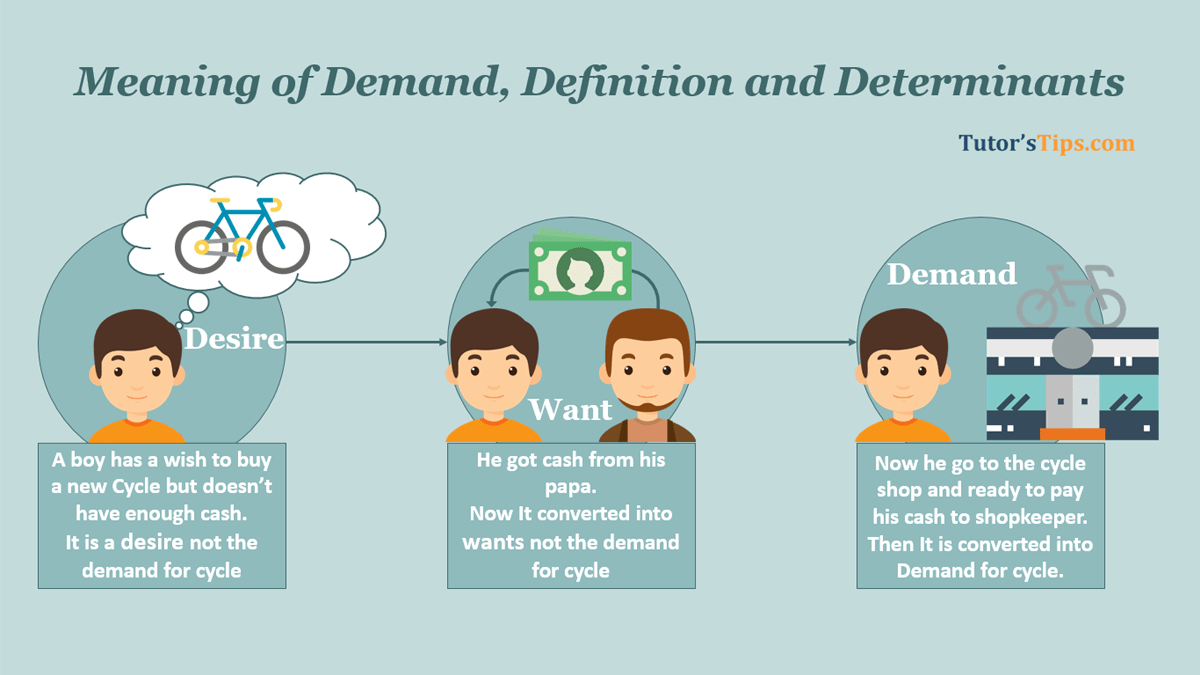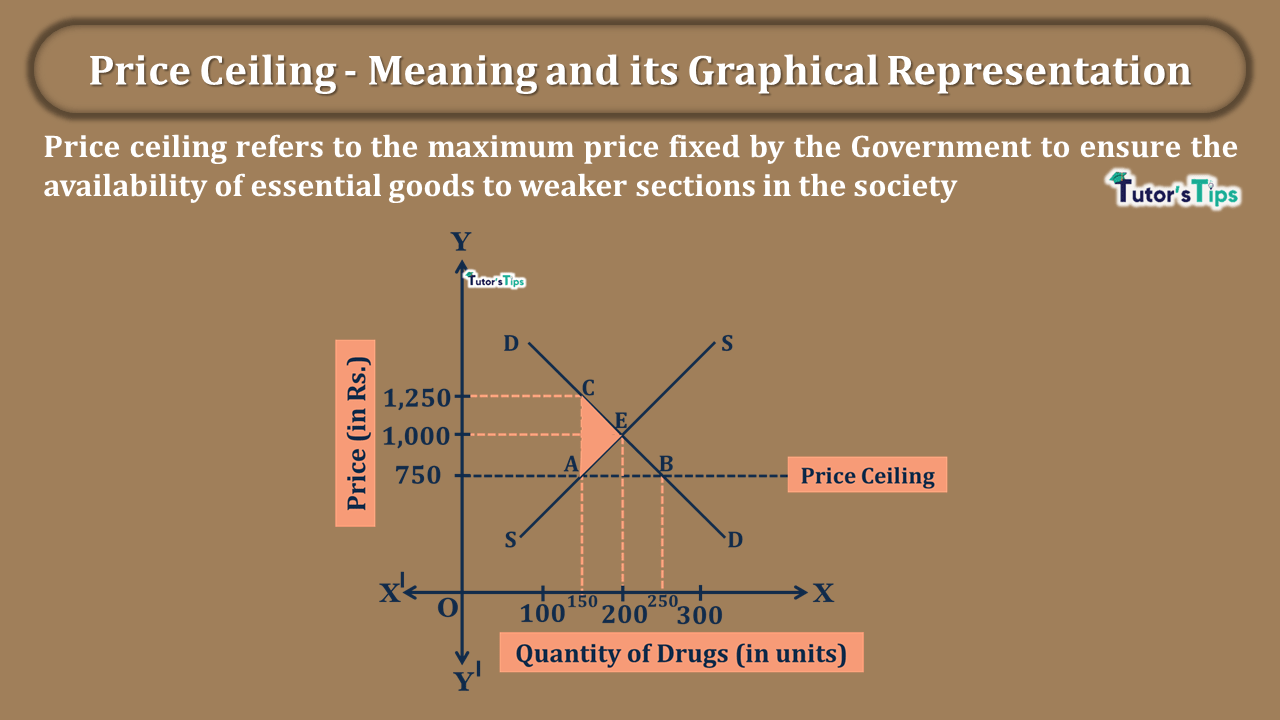Demand refers to the consumer’s desire to buy a good or service and willingness to pay price for the consumption that particular good or service during a given period of time.
Meaning of Demand in economics:-
The demand for the commodity can be described as its quantity at which consumer is willing and able to purchase or consume a given commodity during a given period of time.
So, the commodity can be said as demanded when
- A consumer possesses the willingness to buy it
- Possesses the ability to purchase or consume it
- And it is related to a given period of time.
For example:
Suppose Saurabh wants to purchase a motorbike for himself but he does not have sufficient money to buy it. It cannot be treated as demand. When he can afford the purchase of that motorbike in a given time, it can be called as demand for the motorbike by Saurabh.
Subscribe our Youtube Channel
Definitions of Demand:-
According to Prof. Bober,
“By demand, we mean the various quantities of a given commodity or service which consumers could buy in a given period of time at various prices or at various incomes or at various prices of related goods.”
According to Ferguson,
“Demand refers to the quantities of a commodity that the consumers are able and willing to buy at each possible price during a given period of time, other things being equal.”
According to B.R. Schiller,
“Demand is the ability and willingness to buy a specific quantity of a good at alternative prices in a given period of time, ceteris paribus.”
Determinants of Demand:
It refers to the factors which influence the demand for a particular commodity for a given period of time.
Advertisement-X
In other words, these factors directly or indirectly affect the demand for the commodity in the market. This can also be written as
Individual demand is the function of following main five determinants:
Qd = f ( P, Y, R, T, E)
Where:
- Qd denotes quantity demanded
- f denotes the function
- P denotes the price of the commodity
- Y denotes income of consumers
- R denotes the price of related goods
- T denotes tastes and preferences
- E denotes expectations of consumers
Factors affecting market demand:
Qd = f ( P, Y, R, T, E, N, YD )
An organization should understand the impact of these determinants of the demand. Some of these are explained as under :
1) The Price of the commodity:
It is the most important determinant. It affects the demand for goods at a large extent. As the law of demand, there is an inverse relationship between the price of commodity and Qd. the Qd increases with a reduction in price, assuming other things constant and vice versa.
For example,
A consumer prefers to make bulk quantity purchases when prices are less and makes fewer purchases when prices are high.
Advertisement-X
2) The income of consumers:
Income is another main determinant which represents the purchasing power of the consumer. When income increases, the consumer starts purchasing more which results in more demand and vice versa while other factors remain constant. Income and demand are directly related to each other in case of normal and superior goods.
For example:
Suppose if the salary of Mr A has increased, then he can purchase some luxury items such as television, air conditioners, and accessories.
The relationship between income and different types of goods can be discussed as under :
Normal or Consumer goods:
These refer to the goods which are consumed by all the people in society on a daily basis such as soaps, toothpaste, grains, clothes, etc. As the income increases, the Qd of consumer goods increases but up to a certain limit, other things remain the same.
Inferior goods:
Inferior goods are those whose demand decreases when income increases and vice versa. For example, public transportation, generic grocery products, and kerosene, etc.
However, the goods are not always inferior or normal goods as inferior goods are normal goods for the people having a low level of income. Therefore, we can say that the level of income creates the perception of goods i.e normal or inferior.
3) The Price of related goods :
Demand for a given commodity can be influenced by the price of related goods. These related goods can be classified as :
Substitute goods:
Substitute goods are those which can be used in place of each other for the satisfaction of some want e.g. tea and coffee, coke and limen Soda etc. There is a direct relationship between the price of substitute goods and given commodity, other things remain constant and vice versa. It implies as the price of substitute goods increases, the Qd for given commodity starts increasing.
For example, If the price of coke increases, it will result in more Qd for Limca as the Limca will become cheaper as compared to coke. Thus the price of substitute goods directly affects the Qd for the given commodity.
Complementary goods:
complementary goods are those which are used together to satisfy a specific need such as cars and petrol, shoes and polish, pencils and erasers etc. there is a negative relationship between prices of complementary goods and Qd of the given commodity. It implies that as the price of complementary goods rises, the Qd for given commodity starts declining, other things being constant and vice versa.
Advertisement-X
For example, as the price of shoes starts increasing, the Qd for polish starts decreasing as it will become expensive when used together. So, the demand for a given commodity is inversely affected by the price of complementary goods.
4) Tastes and preferences:
Tastes and preferences have a great impact on the demand for the given commodity. These are highly influenced by the change in trends, fashion, lifestyle, sex, age, religious values, standard living, customs and common habits. Any change in these factors results in a change in tastes and preferences of consumers. Consumers switch over to new products in place of old ones for their consumption.
Also, the sex ratio, habits and age influences the demand for the product in a particular area. For example, if the number of females is more as compared to males in a specific area, the demand for feminine products will be more in that area such as makeup kits and cosmetics material.
5) Expectations of consumers:
If the price of the product is expected to rise in future, the consumers demand more to store it in the short run. For example, if it is expected that the prices of petrol and diesel will increase by next week, the demand for petrol and diesel would increase in present.
Similarly, if there is an expectation that the prices of products will fall in future, the consumers would delay the purchases of that product. Thus, price expectations also make a significant impact on the demand of buyers.
6) Growth of population:
The size of the population determines aggregate demand in the country. More the growth of population more will be the demand and vice versa. Thus, the growth of population is directly related to demand of the commodities. For example, if the population in an economy is more, there will be more demand for food grains, pulses and other consumer goods.
7) Distribution of National Income:
The market demand is highly influenced by the distribution of national income. The even distribution of national income creates a market demand for necessities goods and on the other hand, uneven distribution of national income creates a demand for luxury goods.
8) Credit availability:
The easy access to credit affects the demand for the given commodity at a large extent. It boosts up the demand in the economy as the consumers with a low level of income can afford expensive products such as consumer durables in instalments.
It increases the customer base for the business. Thus, most firms use this method to increase demand and sales of its products such as washing machines, refrigerators, LED Television and luxury cars etc.
9) Taxation and subsidies:
These refer to one of the major factors to affect the demand for commodities. Govt policy influences the demand through tax rates and subsidies in the market. For example, if the tax rate on a specific product is high, it will increase the price of the product. This would result in fall in the demand for that particular product and vice versa.
Advertisement-X
Similarly, the subsidies lower the price of the product and lead to more demand for the product in the market. Thus, low tax rates and more subsidies boost up the demand in the market and vice versa.
10) Climatic conditions:
The demand for some products varies with the climatic conditions of a specific area. For example, tea and coffee are more demanded in winter season whereas ice cream is more demanded in the summer season. Similarly, there are some specific products such as umbrella which are highly demanded in hilly areas as compared to plains. Thus, consumers demand different products under different climatic conditions.
Apart from the factors discussed above, there may be more determinants affecting the demand of a particular commodity. To be precise, some factors are important for one commodity and others could be for other commodities. Therefore, the importance of different factors varies with the buyers.
Thanks for reading the topic
please comment your feedback in comment box whatever you want. If you have any question please ask us by commenting us
References:
Introductory Microeconomics – Class 11 – CBSE (2020-21)







5 Comments